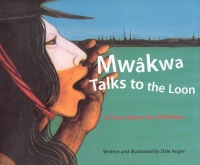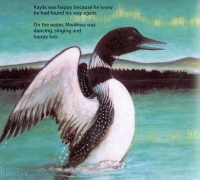| ________________
CM . . .
. Volume XIII Number 5 . . . .October 27, 2006 
 |
Mwâkwa Talks to the Loon: A Cree Story for Children.
Dale Auger.
Surrey, BC: Heritage House, 2006.
32 pp., cloth, $24.95.
ISBN 1-894974-04-2.
Subject Headings:
Cree Indians-Juvenile fiction.
Nature-Juvenile fiction.
Loons-Juvenile fiction.
Grades 3-5 / Ages 8-10.
Review by Gregory Bryan.
**** /4
|
| |
|

excerpt:
Then The People started getting hungry, and they wondered why Kayâs wasn’t hunting anymore.
The People stopped praising the young man and started saying to him, “You should go hunting instead of sitting around the village. The birchbark baskets and drying racks are empty. Namakîkway astîw waskwayoyâkanihk ekwa akwâwânihk. What will we eat? We are hungry. Ninohtîhkatânân.”
Dale Auger is a Sakaw Cree from the Bigstone Cree Nation. In Mwâkwa Talks to the Loon: A Cree Story for Children, Auger combines his knowledge of, and enthusiasm for, his Cree heritage with an undeniable talent for storytelling and stunning visual artistry. The result is an evocative, educational and thought-provoking new picture book from Heritage House Publishing. What’s more, the result is a thoroughly enjoyable reading and viewing experience for readers young and old.
The story’s protagonist, Kayâs, was a renowned hunter, admired by all for his ability to provide The People with the food necessary for their existence. Whenever The People were hungry, Kayâs would search the surrounding lakes and woods for the fish, animals and birds that sustain the village. Kayâs’ special Gift was that he “knew the ways of The Beings he hunted.” Indeed, Kayâs could even speak the languages of the creatures of the water, woods and air.
Over time, Kayâs became somewhat of a celebrity in the village. The People praised him and showered him with attention. Unfortunately, it did not take too long until Kayâs “loved the attention more than he loved hunting.” Kayâs began to neglect his responsibilities, passing his time parading through the village. After a time the hungry People began to scorn Kayâs. Alas, when Kayâs returned to hunting, he found that he had lost his Gift.
Fortunately for Kayâs and for The People, the Elders of the village advise Kayâs to call upon Mwâkwa, the Loon. Mwâkwa owes The People a favour. At Kayâs’ request, Mwâkwa is able to help the hunter provide food for the hungry village.
In our individualistic, egotistical modern world, Kayâs’ story is an important one about the qualities of service and humility. It also contains an important message about the need to give thanks for the gifts that we enjoy. Furthermore, Mwâkwa Talks to the Loon contains environmental messages about our reliance on the natural world around us, and the necessity for us to attend carefully to our stewardship of the Earth.
 The text includes a liberal infusion of Cree words. At the book’s end, a glossary and pronunciation guide are included for the Cree words and phrases. Because of the way the story is written, however, it is not necessary to turn to the glossary and interrupt the flow of the narrative during the initial reading experience. Rather, the Cree words are supported by enough context that one is able to discern the words’ meanings. Indeed, in most cases, the Cree words are immediately preceded or followed by the English equivalent. I like the fact that the Cree glossary and pronunciation guide is included, but it should be understood that its existence is no need for concern; rather, the Cree words add to the authenticity of the story and the educational value of the book.
The text includes a liberal infusion of Cree words. At the book’s end, a glossary and pronunciation guide are included for the Cree words and phrases. Because of the way the story is written, however, it is not necessary to turn to the glossary and interrupt the flow of the narrative during the initial reading experience. Rather, the Cree words are supported by enough context that one is able to discern the words’ meanings. Indeed, in most cases, the Cree words are immediately preceded or followed by the English equivalent. I like the fact that the Cree glossary and pronunciation guide is included, but it should be understood that its existence is no need for concern; rather, the Cree words add to the authenticity of the story and the educational value of the book.
Auger’s storytelling is enhanced as much by his vividly coloured artwork as by his words. The illustrations were created with acrylic on paper, and, through this medium, Auger has achieved an aesthetically pleasing texture in his work. Auger’s paintings have an almost spiritual, mystical nature to them. He provides a mixture of interior, exterior and underwater images, all compelling and alluring. I find the depiction of Mwâkwa especially appealing. Even though the loon paintings retain the spiritual nature of the other illustrations, there is also a photographic realism to the way Mwâkwa has been painted. For me, the best painting of all is the one of Kayâs conversing with nikwîmîy, his same-spirit. Mwâkwa, beak wide open, recognizes the kinship shared with Kayâs, who wears the totemic image of the loon on his head.
Auger’s masterful integration of language and art creates an important work with boundless relevance well beyond that of the Cree culture. This is a book for one and all.
Highly Recommended.
Gregory Bryan is a member of the Faculty of Education at the University of Manitoba in Winnipeg, MB.

To comment
on this title or this review, send mail to cm@umanitoba.ca.
Copyright © the Manitoba Library Association. Reproduction for personal
use is permitted only if this copyright notice is maintained. Any
other reproduction is prohibited without permission.
NEXT REVIEW |
TABLE OF CONTENTS FOR THIS ISSUE
- October 27, 2006.
AUTHORS |
TITLES |
MEDIA REVIEWS |
PROFILES |
BACK ISSUES |
SEARCH |
CMARCHIVE |
HOME |

 The text includes a liberal infusion of Cree words. At the book’s end, a glossary and pronunciation guide are included for the Cree words and phrases. Because of the way the story is written, however, it is not necessary to turn to the glossary and interrupt the flow of the narrative during the initial reading experience. Rather, the Cree words are supported by enough context that one is able to discern the words’ meanings. Indeed, in most cases, the Cree words are immediately preceded or followed by the English equivalent. I like the fact that the Cree glossary and pronunciation guide is included, but it should be understood that its existence is no need for concern; rather, the Cree words add to the authenticity of the story and the educational value of the book.
The text includes a liberal infusion of Cree words. At the book’s end, a glossary and pronunciation guide are included for the Cree words and phrases. Because of the way the story is written, however, it is not necessary to turn to the glossary and interrupt the flow of the narrative during the initial reading experience. Rather, the Cree words are supported by enough context that one is able to discern the words’ meanings. Indeed, in most cases, the Cree words are immediately preceded or followed by the English equivalent. I like the fact that the Cree glossary and pronunciation guide is included, but it should be understood that its existence is no need for concern; rather, the Cree words add to the authenticity of the story and the educational value of the book.